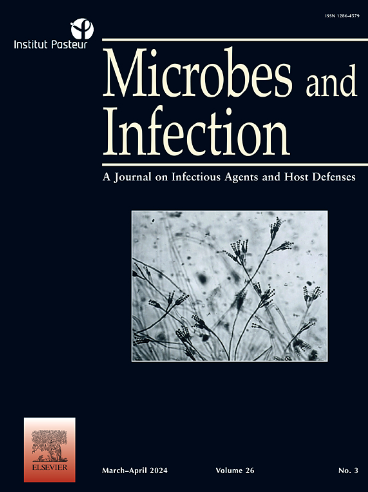The efficacy of the bacteriocinogenic Enterococcus faecalis 14 in the control of induced necrotic enteritis in broilers
IF 2.7
4区 医学
Q3 IMMUNOLOGY
引用次数: 0
Abstract
Purpose
To demonstrate the efficacy of the bacteriocinogenic Enterococcus faecalis 14 (E. faecalis 14) in the control of induced necrotic enteritis (NE) in broilers.
Methods
Six groups of 504 broilers consisting of an infected untreated control (IUC) group, an infected and amoxicillin treated control (ITC) group, and groups receiving prophylactically (2 groups) or therapeutically (2 groups) E. faecalis 14 or its Δbac mutant were used. All groups were challenged with Clostridium perfringens 56 to induce NE. To predispose the boilers to develop subclinical NE, a high protein grower diet containing 15 % fishmeal and a coccidial inoculum were administered.
Results
NE lesions were observed on D26 in all groups except ITC and those receiving prophylactically and therapeutically E. faecalis 14. On D27, only ITC and the group prophylactically treated with E. faecalis 14 (T03) were without lesions. Average body weight and daily weight gain remained lower in the treated groups compared to the ITC group, but there was a clear improvement in the period between D21 to D27, especially in the group prophylactically treated with E. faecalis 14. Specifically, the daily weight gain (DWG) in this period for group T03, was second highest after the group ITC. Metataxonomic analyses showed a positive effect of E. faecalis 14 in maintaining the diversity and richness of the intestinal microbiota, in contrast to ITC group and other conditions.
Conclusions
The results of this in vivo study demonstrated the efficacy of the prophylactic administration of the bacteriocinogenic E. faecalis 14 in preventing of the NE lesions caused by C. perfringens.
产菌性粪肠球菌14对肉鸡诱导性坏死性肠炎的防治效果。
目的:研究产菌性粪肠球菌14 (E. faecalis 14)对肉鸡诱导坏死性肠炎(NE)的控制作用。方法:选取6组504只肉鸡,分为感染未处理对照组(IUC)、感染和阿莫西林处理对照组(ITC)、预防组(2组)和治疗组(2组)。各组均以产气荚膜梭菌56攻毒诱导NE。为了使锅炉易患亚临床NE,饲喂含有15%鱼粉的高蛋白饲料和球虫接种剂。结果:除ITC组和预防性和治疗性粪肠球菌14组外,其余各组D26均有NE病变。D27时,只有ITC组和预防粪肠杆菌14 (T03 T03)组无病变。与ITC组相比,治疗组的平均体重和日增重仍然较低,但在D21至D27期间有明显改善,特别是在用粪肠球菌进行预防性治疗的组14。具体而言,T03组在此期间的日增重(DWG)仅次于ITC组。元分类学分析显示,与ITC组和其他条件相比,E. faecalis 14在维持肠道微生物群的多样性和丰富度方面具有积极作用。结论:本体内研究结果表明,预防性给药产菌性E. faecalis 14对产气荚膜荚膜杆菌引起的NE病变具有预防作用。
本文章由计算机程序翻译,如有差异,请以英文原文为准。
求助全文
约1分钟内获得全文
求助全文
来源期刊

Microbes and Infection
医学-病毒学
CiteScore
12.60
自引率
1.70%
发文量
90
审稿时长
40 days
期刊介绍:
Microbes and Infection publishes 10 peer-reviewed issues per year in all fields of infection and immunity, covering the different levels of host-microbe interactions, and in particular:
the molecular biology and cell biology of the crosstalk between hosts (human and model organisms) and microbes (viruses, bacteria, parasites and fungi), including molecular virulence and evasion mechanisms.
the immune response to infection, including pathogenesis and host susceptibility.
emerging human infectious diseases.
systems immunology.
molecular epidemiology/genetics of host pathogen interactions.
microbiota and host "interactions".
vaccine development, including novel strategies and adjuvants.
Clinical studies, accounts of clinical trials and biomarker studies in infectious diseases are within the scope of the journal.
Microbes and Infection publishes articles on human pathogens or pathogens of model systems. However, articles on other microbes can be published if they contribute to our understanding of basic mechanisms of host-pathogen interactions. Purely descriptive and preliminary studies are discouraged.
 求助内容:
求助内容: 应助结果提醒方式:
应助结果提醒方式:


